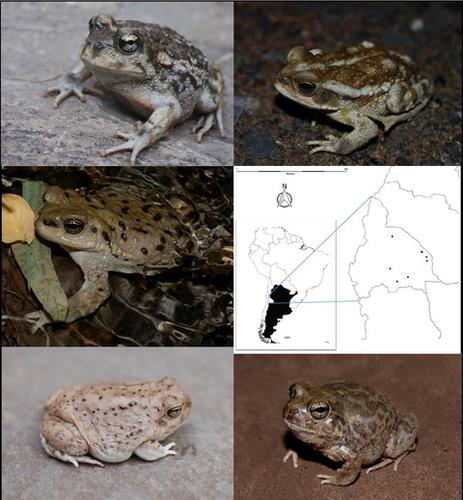Our official English website, www.x-mol.net, welcomes your
feedback! (Note: you will need to create a separate account there.)
Vulnerability to warming in a desert amphibian tadpole community: the role of interpopulational variation
Journal of Zoology ( IF 1.9 ) Pub Date : 2020-12-17 , DOI: 10.1111/jzo.12850 E. A. Sanabria 1, 2, 3 , E. González 3, 4 , L. B. Quiroga 1, 3 , M. Tejedo 5
Journal of Zoology ( IF 1.9 ) Pub Date : 2020-12-17 , DOI: 10.1111/jzo.12850 E. A. Sanabria 1, 2, 3 , E. González 3, 4 , L. B. Quiroga 1, 3 , M. Tejedo 5
Affiliation

|
Current assessments of organismal vulnerability to global warming are focusing on physiological trait‐based indices that may allow biologically sounding estimates of heating risk at the local scale. However, intraspecific variability in both exposure and physiological performance may determine large heterogeneity in the distribution of heating risks through the overall species range compromising whole species risk assessments. We examine intra‐ and interspecific variability in two vulnerability indexes: warming tolerances (WT), or the extent that maximum temperatures (T
max) reaching upper thermal tolerances (CTmax); and thermal safety margin (TSM), or the magnitude that average environmental temperatures (T
mean) exceeding the selected or preferred temperatures (T
sel), in a subtropical warm amphibian tadpole community, at the Monte Desert ecoregion, Argentina. Tadpole populations breeds in temporary ponds and permanent streams that exhibit high thermal heterogeneity. Those populations and species living in hot water bodies, although exhibiting higher CTmax, have lower WT and are more prone to suffer acute heat impacts, thus confirming the prediction of higher thermal risk in ectotherms exposed to higher temperatures. However, these hot pond breeders, although living closer to their CTmax, also preferred high temperatures, showing higher TSMs and being actually exposed to a lower proportion of stressful temperatures than cool selecting populations. Both WT and TSM indexes have significant interpopulational variation. Thus, our findings suggest that attempts to build mechanistic models to forecast species vulnerability to heat stress due to climate change have to include physiological variation among populations.
中文翻译:

沙漠两栖动物t变暖的脆弱性:种群间变异的作用
当前对生物体对全球变暖的脆弱性的评估主要集中在基于生理性状的指标上,这些指标可以对当地范围内的加热风险进行生物学上的估计。但是,暴露和生理表现的种内变异性可能会通过整个物种范围损害整个物种风险评估,从而确定供暖风险的分布存在很大的异质性。我们研究了两个脆弱性指标的种内和种间变异性:温暖容忍度(WT),或最高温度(T max)达到较高热容忍度(CT max)的程度;热安全裕度(TSM)或平均环境温度的大小(T 均值)在阿根廷蒙特沙漠生态区的亚热带温暖的两栖t种群中超过了选定的或优选的温度(T sel)。population种群在临时池塘和永久溪流中繁殖,它们表现出很高的热异质性。生活在热水体中的那些种群和物种,尽管表现出最大的CT max,但具有较低的WT,并且更容易遭受急性热影响,因此证实了对暴露于较高温度的等温线中较高热风险的预测。但是,这些热塘饲养员虽然生活在其最大CT值附近也是首选的高温,它显示出较高的TSM值,并且实际上比凉爽的选择群体所承受的压力温度比例低。WT和TSM指标均具有显着的种群间差异。因此,我们的发现表明,建立机制模型以预测物种因气候变化而遭受热胁迫的脆弱性的尝试必须包括种群之间的生理变异。
更新日期:2020-12-17
中文翻译:

沙漠两栖动物t变暖的脆弱性:种群间变异的作用
当前对生物体对全球变暖的脆弱性的评估主要集中在基于生理性状的指标上,这些指标可以对当地范围内的加热风险进行生物学上的估计。但是,暴露和生理表现的种内变异性可能会通过整个物种范围损害整个物种风险评估,从而确定供暖风险的分布存在很大的异质性。我们研究了两个脆弱性指标的种内和种间变异性:温暖容忍度(WT),或最高温度(T max)达到较高热容忍度(CT max)的程度;热安全裕度(TSM)或平均环境温度的大小(T 均值)在阿根廷蒙特沙漠生态区的亚热带温暖的两栖t种群中超过了选定的或优选的温度(T sel)。population种群在临时池塘和永久溪流中繁殖,它们表现出很高的热异质性。生活在热水体中的那些种群和物种,尽管表现出最大的CT max,但具有较低的WT,并且更容易遭受急性热影响,因此证实了对暴露于较高温度的等温线中较高热风险的预测。但是,这些热塘饲养员虽然生活在其最大CT值附近也是首选的高温,它显示出较高的TSM值,并且实际上比凉爽的选择群体所承受的压力温度比例低。WT和TSM指标均具有显着的种群间差异。因此,我们的发现表明,建立机制模型以预测物种因气候变化而遭受热胁迫的脆弱性的尝试必须包括种群之间的生理变异。









































 京公网安备 11010802027423号
京公网安备 11010802027423号